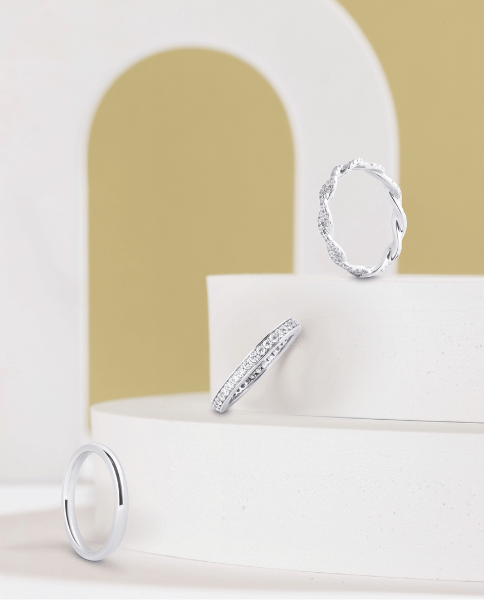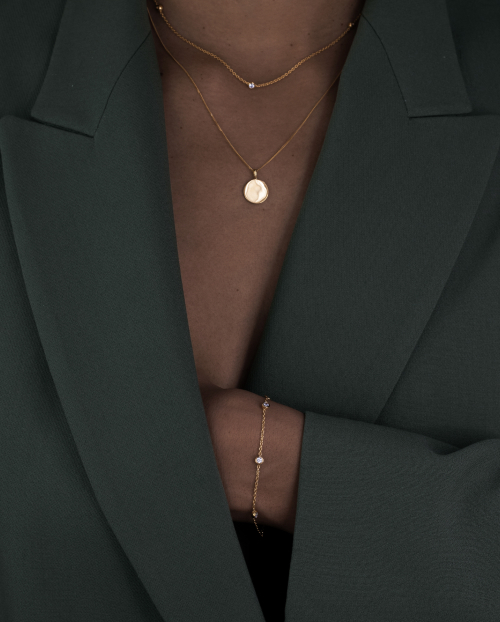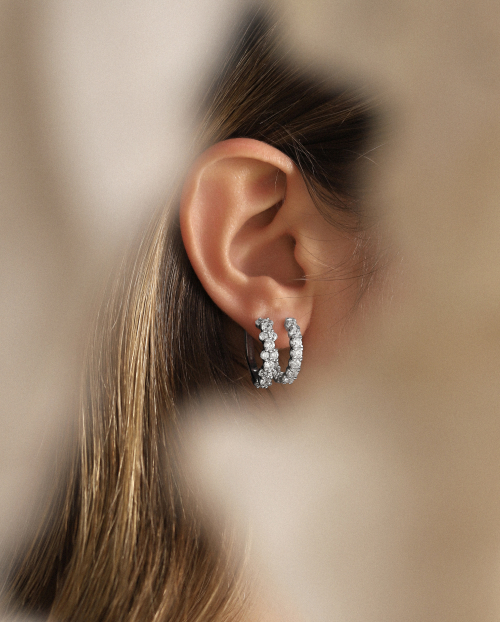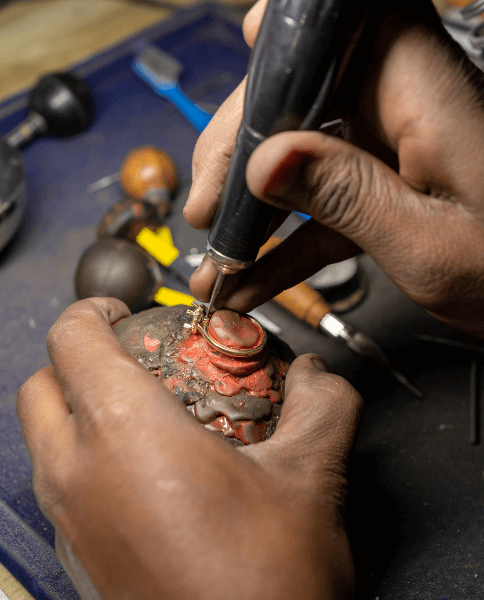Platinum Vs White Gold – What’s the Difference?
When you’re shopping for fine jewellery, one of the key decisions is which precious metal to choose. That’s easy enough if you have a strong preference for rose or yellow gold, but how do you decide between the two white metals – platinum and white gold?
In this blog post, we’ll take a closer look at both of these precious metals, draw out the differences between the two, and help you make the right choice for your Sacet piece.
So, let's get started.
What is White Gold?
White gold is a gold that is white in colour, giving it a sleek, modern appearance that works beautifully with diamonds in contemporary jewellery. Like most of the gold used to make jewellery, white gold is mixed with other metals to make it more durable.
In this case, the pure gold is alloyed with metals such as nickel or palladium to transform its natural yellow hue into a bright white.
What is Platinum?
Platinum is a precious metal that is naturally white in appearance. Its rarity (platinum is 30 times rarer than gold) coupled with its exceptional durability make it a popular choice for fine jewellery. Unlike gold, platinum doesn’t need to be alloyed with a large amount of other metals before it can be made into jewellery; in fact, the platinum used at Sacet is 95% pure.
Platinum Vs White Gold – What’s the Difference?
While platinum and white gold might look very similar at first glance, there are some important differences between the two. Here’s what you need to know:
1. Appearance
In general, platinum is brighter than white gold since it’s naturally bright white in colour. White gold, on the other hand, tends to have more of a shine to it as platinum will acquire a patina over time.
2. Durability
Platinum is both denser (and therefore heavier) and less malleable than white gold. So it can be a more durable option for jewellery that you wear every day.
3. Purity
Gold is slightly softer than platinum, and so it needs to be alloyed with other metals before being made into jewellery. For example, our 9k gold is 37.5% pure gold, while 18k gold contains 75% pure gold. Platinum, on the other hand, is a harder metal that can be used in its near-pure form.
4. Hypoallergenic properties
White gold is alloyed with other metals such as nickel. Because the platinum used in jewellery is purer at 95% pure platinum, it’s a good choice if you have allergies or sensitivities to certain metals.
5. Price and budget considerations
Platinum is more expensive than white gold for a number of reasons. First, its relative rarity. Then you have to consider the density – platinum jewellery weighs more. Finally, the platinum used in jewellery has a higher purity than gold. This is all reflected in the price.
6. Environment impact and sustainability
While gold and platinum mining have an impact on the environment, the good news is that these metals can be melted down and recycled. So both metals can be a sustainable choice if you go for recycled gold or platinum in your jewellery.
7. Finish
White gold owes its bright white finish to rhodium or palladium plating, which will fade over time. Platinum, while naturally brighter in appearance, has a slightly duller finish.
8. Customisation and design possibilities
Both platinum and white gold are beautiful, durable precious metals that open up a world of possibilities when it comes to designing or customising a special piece of jewellery. However, platinum is less malleable than gold, and can therefore be a little harder for jewellers to work with.
9. Ethical considerations
Conscious consumers can wear both platinum and white gold jewellery with a clean conscience, provided they have been ethically sourced. At Sacet, we only work with recycled metal to minimise our impact on the environment.
10. Popularity and Trends
If you were choosing between metals of different colours, such as rose gold and platinum, your choice might well come down to the whims of fashion. But because white gold and platinum are so similar in appearance, there’s very little to separate them in terms of trends. Both metals have a streamlined, contemporary look with a popularity that endures.
11. Weight
Platinum is denser than white gold, which means that a piece of platinum jewellery will feel slightly heavier than its white gold counterpart. Some people appreciate the heft of platinum while others prefer the lighter feel of white gold for everyday. It all comes down to your own personal style.
12. Maintenance and care
While white gold is less expensive than platinum in the short term, you may need to factor in the cost of maintenance over time. White gold will need replating every few years to maintain its bright white lustre. Platinum, on the other hand, will develop a patina over the years, so you might want to have it polished every year or so to restore its original shine.
Shopping Considerations
Still swithering between white gold and platinum jewellery? Before you start shopping for your next precious piece, we’ve put together some expert tips to help you decide between the two.
1) In the first instance, find the right jeweller. It’s not just a question of aesthetics, although of course it’s important to choose a jeweller whose designs chime with your own sense of style.
2) Ethical values and sustainability are also increasingly important; for example, you might want to work with a jeweller who sources recycled precious metal to reduce their environmental impact.
3) If you have sensitive skin, our experts recommend choosing platinum over white gold, which might have metals such as nickel in the mix. Finally, think about your personal style and the jewellery you already own.
These days, it’s perfectly acceptable to mix and match your metals. If you’re wearing white gold rings, for example, don’t feel that you have to stick to white gold jewellery everywhere else. However, our in-house team does advise treading carefully when it comes to wearing different metals next to each other as they can scratch each other over time.
Select the Best Jewellery with Sacet
As we’ve seen, there are some important differences between platinum and white gold, both in terms of how they look, their durability, and how best to care for them. Naturally bright white, platinum is denser and more durable than white gold, and is a good choice if you’re looking for a hypoallergenic metal. White gold is shinier than platinum, and can be a more budget-friendly option.
At Sacet, all of our jewellery is made to order so you can choose the metal that best suits your style. Whether you opt for white gold or platinum, you can shop safe in the knowledge that every style is designed to make you feel good – made from recycled precious metals and set with lab-grown diamonds for a more conscious approach to fine jewellery.
FAQs
1. How does the appearance of platinum differ from that of white gold?
While platinum and white gold are both white metals, there are subtle differences in the way they look. Platinum is naturally white in colour; white gold, on the other hand, is alloyed with other metals to give it its bright white appearance.
So you might see white gold turning slightly warmer and yellower over time. Platinum also acquires a dull patina as it ages. You can choose to have it polished to restore its original lustre; or simply enjoy the way your diamond sparkles all the brighter by comparison.
2. How does the maintenance and care of platinum jewellery compare to that of white gold?
White gold is traditionally plated with rhodium, and will need replating every two to three years (although palladium plating may last longer). Platinum is a durable metal that doesn’t tarnish, and, unlike white gold, it won’t need to be replated. But it does develop a patina over time, which means that you might want to have it polished every year or so to restore its just-bought lustre.
3. Are there any environmental or ethical considerations when choosing between platinum and white gold?
Both white gold and platinum are precious metals that can be endlessly recycled, retaining their pure form every time they’re melted down. So if you opt for recycled metal, you’ll be making an environmentally conscious choice no matter which one you go for. At Sacet, all of our jewellery is made from recycled metal, reducing our impact on the environment.
4. Which metal typically holds diamonds more securely: platinum or white gold?
Platinum is less malleable than yellow gold, which means that it’s not easily bent out of shape. Technically, this gives platinum the edge when it comes to holding diamonds more securely, particularly when you consider that platinum is also denser, and therefore heavier, than gold. In practice, however, both platinum and white gold are durable metals that will hold diamonds securely in a piece of fine jewellery.
5. How often should platinum and white gold jewellery be polished?
In general, we recommend having your jewellery checked, cleaned and polished if necessary by a professional once a year, and this holds true for both platinum and white gold. However, when you polish platinum, there’s no loss of metal – so you can safely have platinum repolished without losing any of its weight. When you polish gold, on the other hand, you will lose a small percentage of the metal, so you may want to have white gold jewellery polished less often.
6. Can platinum and white gold be worn together in the same jewellery piece?
Yes, in principle. Because platinum is less malleable than gold, some jewellers offer white gold jewellery with the gemstones held in a platinum setting. However, when two different metals rub up against each other, there’s a risk that they will scratch each other and cause damage over time. At Sacet, we don’t mix gold and platinum in the same piece.
7. Can white gold be resized like platinum?
Yes, both white gold and platinum rings can be easily resized to ensure the perfect fit.

















































